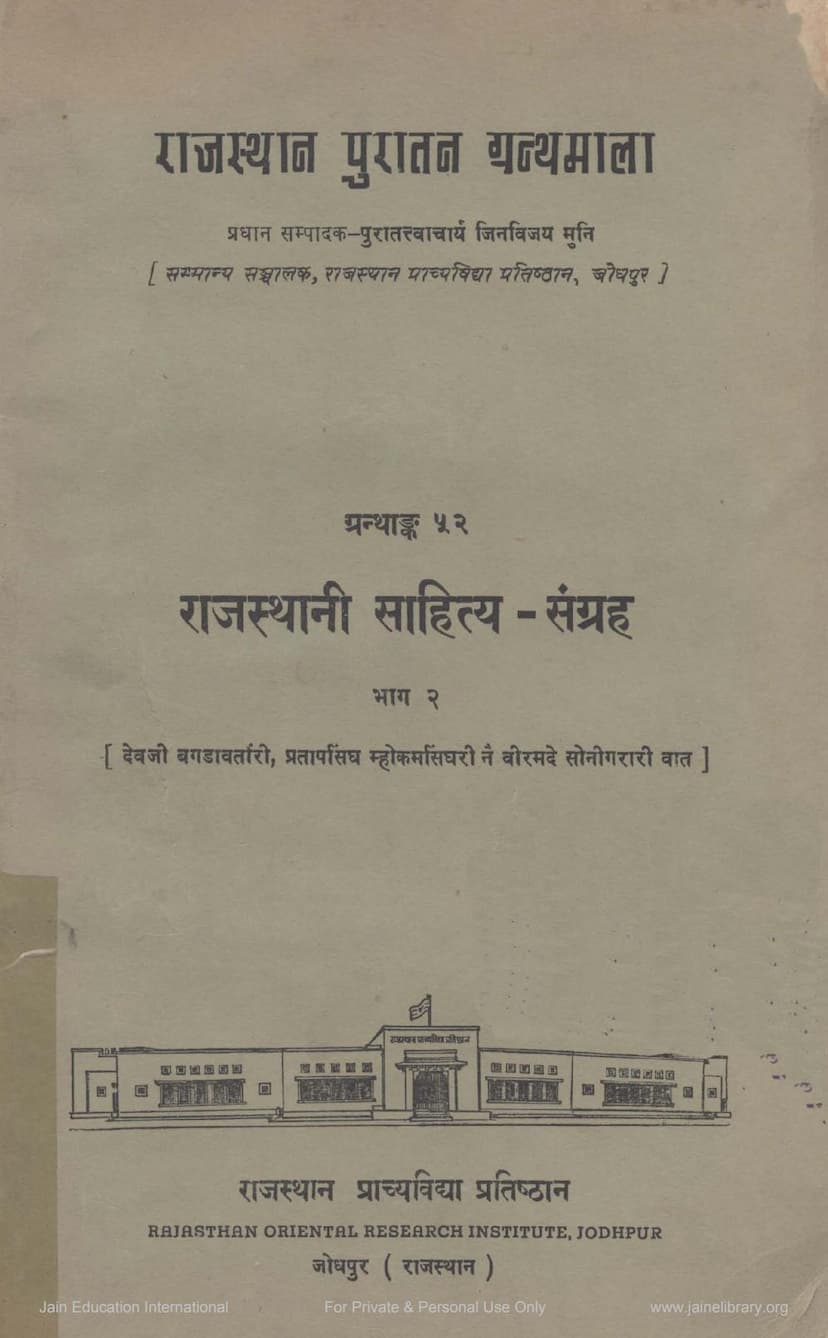Rajasthani Sahitya Sangraha 02
Added to library: September 2, 2025

Summary
Here's a comprehensive summary of the Jain text "Rajasthani Sahitya Sangraha 02," based on the provided pages:
Book Title: Rajasthani Sahitya Sangraha (Collection of Rajasthani Literature) Volume: Part 2 Author: Purushottamlal Menariya Publisher: Rajasthan Prachyavidya Pratishthan, Jodhpur Publication Year: V.S. 2017 (1960 AD)
This publication, part of the "Rajasthan Puratana Granthamala" series, is a significant collection of Rajasthani literature, specifically focusing on three important narratives, known as "Vatas" (stories/tales). The general editor, Acharya Jinavijaya Muni, emphasizes the importance of these narratives in understanding the historical, social, political, linguistic, and literary traditions of Rajasthan. The publication is supported by the Government of Rajasthan and partially funded by the Central Government under the Regional Language Development Plan.
The volume contains the following three Vatas:
-
Devji Bagdawataari Vata (The Tale of Devji Bagadavat):
- Author: Unknown.
- Content: This Vata provides significant information about the Bagadavat lineage and specifically about Devji. Devji is revered as a folk deity in Rajasthan, particularly by the Gurjar community. The narrative begins with the reign of King Visaldev Chauhan in Ajmer and details the origin of the Bagadavat lineage from Hariram Chauhan. It describes the birth of Devji, who was born with a lion's physique, and the subsequent growth and activities of his twenty-four sons, known as the Bagadavats. The Vata explores the lineage's prosperity, their marriages with Gurjar girls, and their eventual establishment in twenty-four villages. It also touches upon their defiance of the local ruler Rana (of Bhinay) and mentions Devji's temple built by Maharana Sanga in Chittor. The text highlights the fusion of historical events with folklore and mythological elements, common in Indian narrative traditions. The Bagadavat epic is considered to be of immense historical and literary value, comparable to "Prithviraj Raso."
- Key Themes: Folk deities, epic narratives, lineage and ancestry, chivalry, religious and mythological elements, cultural practices.
- Linguistic Features: The Vata showcases literary Rajasthani language and includes various Indian narrative conventions and motifs.
-
Prataapsingh Mohokamsinghari Vata (The Tale of Prataapsingh and Mohokamsingh):
- Author: Maharaja Bahadur Singh of Kishangarh.
- Inspiration for Editing: Pt. Gopalanarayan Bahura, Deputy Director of the Rajasthan Oriental Research Institute.
- Content: This is a historical narrative that has been utilized by scholars like Dr. Gaurishankar Hirachand Ojha in his history of Rajputana. It focuses on the valiant characters of Rawat Prataapsingh, the founder of Pratapgarh, and his younger brother Mohokamsingh. The Vata describes their bravery and contributions. It also includes details about the military strategies and practices of the post-Mughal era, making it a valuable source for understanding warfare during that period. The narrative recounts Prataapsingh's interaction with various rulers and his participation in significant events, including a conflict with rebellious Dodiya Rajputs. The author, Bahadur Singh, is portrayed as a virtuous, learned, and skilled ruler, whose personality and reign are further illuminated by the inclusion of his own poetic verses (kavittas and geet).
- Key Themes: Valour, heroism, chivalry, political history, military life, courtly poetry, royal patronage of literature.
- Linguistic Features: This Vata is considered a highly excellent work in the Rajasthani language and exhibits the use of "Davait" (a form of prose with rhyming couplets), reflecting the influence of Persian "Dubeti."
-
Viramde Sonigarari Vata (The Tale of Viramde Sonigara):
- Author: Unknown.
- Content: This Vata is semi-historical, based on the conquest of Siwana and Jalore by Alauddin Khilji. It narrates the story of Kanhaddev Sonigara, Viramdev, and the valiant defense of their kingdom. While Muslim historians provide brief mentions of these events, this Vata, along with other Rajasthani historical texts like "Muhanot Nainsi ki Khyat" and "Vankidas ki Khyat," offers detailed accounts of the sacrifices made by the Rajput warriors and women. The narrative skillfully blends historical facts with popular legends and mythological elements, such as the miraculous birth of Viramdev from a stone sculpture brought to life. The story includes events like Viramdev's marriage to Alauddin's daughter, which is presented as a blend of historical possibility and narrative license, reflecting the impact of Sufi saints and prevalent romantic traditions in medieval India. The Vata highlights the bravery of the Rajput warriors and the tragic fall of Jalore.
- Key Themes: Historical events, legendary figures, chivalry, sacrifice, defense of homeland, historical and mythological fusion, cultural narratives, courtly life, and warfare.
- Linguistic Features: The Vata showcases literary Rajasthani and incorporates traditional Indian narrative tropes.
Overall Significance:
The "Rajasthani Sahitya Sangraha, Part 2" is a crucial publication for scholars and readers interested in Rajasthani literature and history. It preserves and presents three significant Vatas that offer insights into the region's rich cultural heritage, heroic traditions, and storytelling artistry. The detailed introduction, notes, and appendices by the editor, Purushottamlal Menariya, enhance the scholarly value of the collection, providing historical context and linguistic analysis. The book also indirectly sheds light on the literary trends and influences present in Rajasthani literature during the periods when these Vatas were composed.